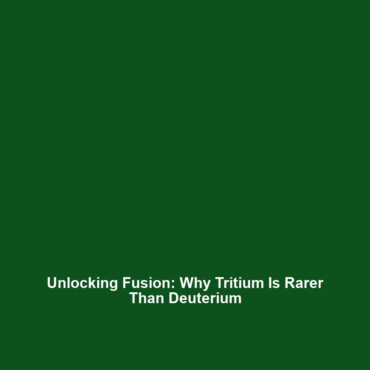What is Fusion Energy?
Fusion energy is a fundamental yet complex scientific concept that provides insights into clean and limitless energy production. As the world seeks sustainable energy solutions, understanding what fusion energy entails is pivotal. By harnessing the power of atomic nuclei, fusion promises a future where energy is abundant and environmentally friendly. This article delves into the intricacies of fusion energy, its potential applications, the challenges it faces, and the innovations on the horizon.
Key Concepts
At its core, fusion energy refers to the process where two light atomic nuclei combine to form a heavier nucleus, releasing a significant amount of energy in the process. This reaction occurs in stars, including our Sun, where hydrogen nuclei fuse to create helium. The key concepts associated with fusion energy include:
- Nuclear Fusion Process: The fusion occurs under extreme temperatures and pressures, which overcome the electrostatic repulsion between positively charged nuclei.
- Plasma State: The state of matter (plasma) required for fusion is created when hydrogen is heated to millions of degrees, allowing nuclei to collide and fuse.
- Energy Yield: Fusion reactions yield far more energy than fission reactions (splitting atomic nuclei), with potential for a virtually inexhaustible energy supply.
Applications and Real-World Uses
Understanding how fusion energy is used can illuminate its transformative potential across various sectors. Current significant applications and real-world uses include:
- Power Generation: Fusion reactors could provide a clean alternative to fossil fuels, significantly reducing greenhouse gas emissions.
- Space Exploration
- Medical Applications: Research into fusion technology could lead to advancements in radiation therapy for cancer treatment.
Current Challenges
Despite its promise, the challenges of fusion energy are significant, including:
- Temperature Requirements: Achieving and maintaining the necessary high temperatures for fusion is a major technical hurdle.
- Energy Input vs. Output: Currently, more energy is required to initiate fusion reactions than is produced.
- Materials Science: Developing materials that can withstand extreme conditions inside fusion reactors is crucial.
Future Research and Innovations
The future of fusion energy holds exciting possibilities. Recent innovations in research are paving the way for breakthroughs, such as:
- ITER Project: An international nuclear fusion research and engineering project aimed at demonstrating the feasibility of fusion as a large-scale and carbon-free source of energy.
- Spherical Tokamaks: New reactor designs are emerging that may simplify fusion research while enhancing efficiency.
- Private Sector Innovation: Companies like Helion and Tokamak Energy are exploring novel approaches to achieve practical fusion faster.
Conclusion
In conclusion, what fusion energy is presents a promising avenue for sustainable energy solutions with the potential to revolutionize energy production. As research progresses and challenges are addressed, the dream of harnessing fusion energy may become a reality. To stay informed about advancements in this field, consider exploring related topics such as the ITER project or the latest in nuclear fission. Join us in advocating for innovative energy solutions that can transform our future.
This -formatted article provides an overview of fusion energy while incorporating SEO best practices through the use of relevant keywords, structured headings, and clear language.


